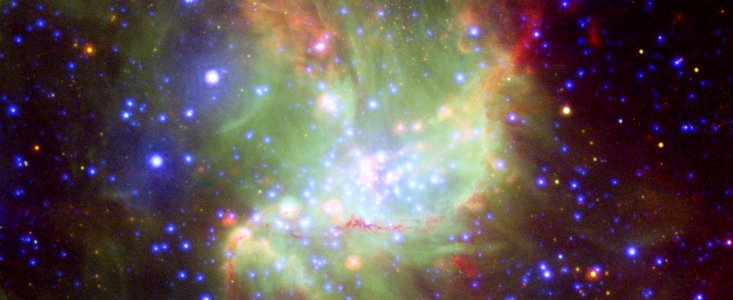Tisková zpráva
Zrozena z větru
Jedinečný víceoborový portrét zrození hvězdy
8. října 2008
Spojením sil pozemních a vesmírných dalekohledů vznikl barvitý obraz oblasti NGC 346, který nabízí nové informace o historii tohoto místa zaplněného hvězdami. Jednotlivé vlnové délky se zde slévají v jediný snímek, podobně jako vodové barvy na plátně, a poskytují nové informace o zrození hvězd.
Snímek kombinuje infračervenou (Spitzer Space Telescope, NASA), viditelnou (New Technology Telescope, ESO) a rentgenovou (XMM-Newton, ESA) oblast záření z trojice různých dalekohledů. Viditelné světlo NTT odhaluje astronomům pouze zářící plyn, zatímco nevšední kombinace víceoborového snímku umožňuje zcela jiný pohled na oblast NGC 346.
Jedná se o nejjasnější oblast vzniku nových hvězd v Malém Magellanově mračnu, nepravidelné trpasličí galaxii, jež obíhá naší Galaxii ve vzdálenosti 210 000 světelných let. „NGC 346 je pravá astronomická zoo,“ říká hlavní autor publikované práce Dimitrios Gouliermis Max Planck institutu v Heidelbergu. „Když různé vlnové délky spojíme v jeden snímek, můžeme odhalit, co se v jednotlivých částech regionu odehrává.“
Menší hvězdy jsou roztroušeny po celé oblasti, zatímco hmotné hvězdy se nacházejí v jejím středu. Jak hmotné, tak většina menších hvězd, vznikly ve stejnou dobu z hustého mračna. Ostatní menší hvězdy vznikly později v důsledku procesu nazývaného „vynucená tvorba hvězd“. Intenzivní záření hmotných hvězd nutí plyn se rozpínat. Vytvoří rázovou vlnu, která stlačí okolní studený plyn a prach, čímž zažehne novou tvorbu hvězd. Oranžovo-červené filamenty ve středu snímku ukazují, kde tento mechanismus působil.
Zdaleka ne všechny menší hvězdy však vznikaly tímto způsobem. Například skupina nacházející se v narůžovělé kapce v horní části snímku musela vzniknout jiným mechanismem. „Velice nás zajímá, jak tato osamělá skupina hvězd vznikla,“ říká Gouliermis. Díky víceoborovému snímku NGC 346 mohl Gouliermis se svým týmem určit, že spouštěcím mechanismem tvorby hvězd v oblasti byl výbuch supernovy přibližně před 50 000 lety. Nikoliv záření, ale silný vítr umírající hvězdy stlačil prach i plyn a byl příčinou vzniku nových hvězd. Přestože na snímku nemůžeme pozůstatky supernovy vidět, je zde jasně zřetelná bublina okolo bílé skvrny s modrým halo v levé horní části snímku (bílá skvrna je ve skutečnosti shluk tří hvězd).
Objev ukazuje, že spouštěcím mechanismem v tomto regionu bylo jak záření tak hvězdný vítr. Podle Gouliermise: „Výsledky nám ukazují, že tvorba hvězd je mnohem komplikovanější, než jsme si mysleli. Jednotlivé mechanismy se mohou doplňovat nebo působit proti sobě.“ Výsledků bylo dosaženo díky kombinaci dat získaných různými technikami a různými přístroji. Práce tak demonstruje sílu spolupráce mezi pozemními a vesmírnými dalekohledy.
Poznámky
D. Gouliermis a kol., NGC 346 in the Small Magellanic Cloud. IV. Triggered Star Formation in the H II Region N 66, v časopise Astrophysical Journal.
Další spoluautoři článku: Thomas Henning, Wolfgang Brandner, Eva Hennekemper, a Felix Hormuth z Max Planck Institute for Astronomy, a You-Hua Chu a Robert Gruendl z University of Illinois v Urbana-Champaign, USA.
New Technology Telescope (NTT), 3,5 metrový dalekohled v La silla v Chile, byl prvním, jenž byl vybaven deformovatelným zrcadlem (systémem aktivní optiky). Technologii vyvinula ESO a v současnosti se používá na většině velkých dalekohledů.
Kontakty
Dimitrios Gouliermis
Max Planck Institute for Astronomy
Heidelberg, Germany
Email: dgoulier@mpia.de
Anežka Srbljanović (press contact Česko)
ESO Science Outreach Network
and Astronomical Institute of Czech Academy of Sciences
Tel.: +420 323 620 116
Email: eson-czech@eso.org
O zprávě
| Tiskové zpráva č.: | eso0834cs |
| Legacy ID: | PR 34/08 |
| Jméno: | NGC 346 |
| Typ: | Local Universe : Nebula : Type : Star Formation |
| Facility: | New Technology Telescope, Spitzer Space Telescope, XMM-Newton |
| Instruments: | EMMI |
| Science data: | 2008ApJ...688.1050G |

